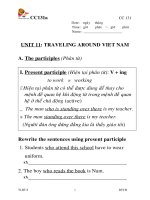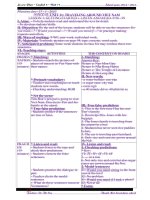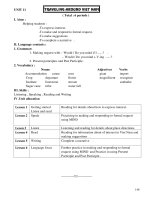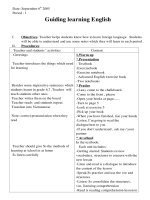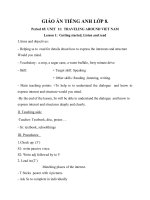Unit 11. Traveling around Vietnam
Bạn đang xem bản rút gọn của tài liệu. Xem và tải ngay bản đầy đủ của tài liệu tại đây (196.53 KB, 11 trang )
<span class='text_page_counter'>(1)</span><div class='page_container' data-page=1>
Period: 70
Week 24 UNIT 11: TRAVELING AROUND VIET NAM
<b>LESSON 1: GETTING STARTED & LISTEN AND READ</b>
<b>I. Objectives</b>
<i><b>1. Knowledge, Skills, Attitude: </b></i>
<i><b>a. Knowledge:</b></i>
- By the end of the lesson, Ss read for details about how to express interest.
<i><b>- Vocabulary: Related to “Traveling around Viet Nam” harbor, 40-minute drive, water buffalo, crop,</b></i>
sugar cane, corn.
<i><b>- Grammar: Would you mind + V-ing? / Would you mind if I + V(past simple)</b></i>
Present participle
<i><b>b. Skills: listening, speaking very less reading and writing</b></i>
<i><b>c. Attitude: Ss will be educated about the love of our country.</b></i>
<i><b>2. Capacity is formed and developed for students</b></i>
- Self-learning capability.
- Communicative competence
- Cooperation capacity
<b>II. Preparation</b>
<i><b>1. Teacher: lesson plane, book, color chalks, pictures, MP3</b></i>
<i><b>2. Students: books, notebooks, pen, ruler …</b></i>
III. Students’ activities
<b>Teacher’s activities</b> <b>Students’ activities</b> <b>Content</b>
- T and Ss talk about
traveling.
- T has Ss work in pairs, look
at the pictures and match the
places with the names, then
say something about them.
- work in pairs, look at
the pictures and match the
places with the names,
then say something about
them.
<i><b>* Warm up (5’) “Chatting” </b></i>
<b>I. Getting started</b>
<i>* Ss know some famous places in VN.</i>
“Do you like traveling?
Have you ever traveled?
Which place did you travel?
Which place do you want to travel if you
have a chance?...”
Matching : ( p/98 )
<i>a. Ngo Mon gate, b. Nha Rong Harbor,</i>
<i>c. The temple of literature, d. Ha Long Bay</i>
T presents some new words
through Ss’ answer.
- T reads loudly.
- T checks.
- T presents some requests.
- T has Sts close their book,
listen and answer the
Questions.
<i>“1. Where does Hoa meet the</i>
<i>Jones?</i>
<i>2. Is it the first time the Jones</i>
<i>have visited Vietnam?</i>
- Ss guess the meaning.
- Ss repeat.
- Ss read loudly before
class.
<b>- close their book, listen </b>
and answer the Questions.
<b>II. Listen and read</b>
<i>* Ss read for details about how to express </i>
<i>interest.</i>
New words:
- water buffalo (n) Trâu nước
- crop (n) vụ mùa
- sugar cane(n) cây mía
- corn (n) ngơ, bắp
- seat (n) chỗ ngồi
- luggage (n) hành lí
- Would you mind sitting…?
- Would you mind if I took a photo?
- I can see a boy riding a water buffalo.
* Would you mind + V-ing? / Would you
mind if I + V(2)
* Present participle : V-ing
<i><b>Answers :</b></i>
<i>1. at the airport</i>
<i>2. Yes, it is</i>
<i>3. What do they see along the</i>
<i>road to Hanoi?</i>
4. What would Tim like to
<i>3. a boy riding a water buffalo, rice paddies,</i>
<i>corn and sugar canes</i>
</div>
<span class='text_page_counter'>(2)</span><div class='page_container' data-page=2>
do?”
- T asks Ss to practice in
groups.
- T has Ss read the dialogue
loudly before the class.
- Ss read loudly before the
class.
- T checks pronunciation.
<b>- practice in groups.</b>
- Ss work in groups.
<b>- read the dialogue loudly</b>
before the class.
<b>* Practice: </b>
<i><b>1. Practice the dialogue in groups.</b></i>
- T has Ss read through the
dialogue and checks the
answers.
- T has Ss look at 2/p.99, read
the dialogue again and decide
T/F. Then correct the false
statements.
-T and Ss check the answers.
<i><b>- read through the </b></i>
dialogue and checks the
answers.
- look at 2/p.99, read the
dialogue again and
decide T/F. Then correct
the false statements
-check
<i><b>2. True or false? Check () the boxes. Then </b></i>
<i><b>correct the false sentences and write them </b></i>
<i><b>in your exercise book.</b></i>
<i> a. T </i>
<i> b. T </i>
<i> c. F (by taxi)</i>
<i> d. T </i>
<i> e. T </i>
f. F (and sugar canes)
<i><b>3. Consolidation (4’)</b></i>
T reminds Ss of how to express interest.
<b>IV. comment:</b>
………
………
………
Period: 71
<b>UNIT 11: TRAVELING AROUND VIET NAM</b>
<b>LESSON 2: SPEAK</b>
<b>I. Objectives</b>
<i><b>1. Knowledge, Skills, Attitude: </b></i>
<i><b>a. Knowledge:</b></i>
- By the end of the lesson, students make suggestions /using “mind” to make requests and giving
responses.
<i><b>- Vocabulary: Related to “Traveling around Viet Nam”</b></i>
<i><b>- Grammar: Would/do you mind + V-ing…?</b></i>
Do you mind if I + V (present simple)…?
Would you mind if I + V (past simple)…?
<i><b>b. Skills: listening, speaking very less reading and writing</b></i>
<i><b>c. Attitude: Ss love Viet Nam </b></i>
<i><b>2. Capacity is formed and developed for students</b></i>
- Self-learning capability.
- Communicative competence
- Cooperation capacity
<b>II. Preparation</b>
<i><b>1. Teacher: lesson plane, book, color chalks </b></i>
<i><b>2. Students: books, notebooks, pen, ruler …</b></i>
<b>III. Students’ activities</b>
</div>
<span class='text_page_counter'>(3)</span><div class='page_container' data-page=3>
<b>Teacher’s activities</b> <b>students’ activities</b> <b>Content</b>
-T asks Ss to talk about
places of interest in Viet
Nam.
<b>- -Ss work in group, </b>
talk about places of
interest in Viet Nam.
<b>“Brainstorming” </b>
Ben Thanh Market Da Lat
Nha Trang
Places of interest in VN
Sa Pa
Nha Rong harbor Ha Long Bay
-T has Sts look at the
dialogue between Hoa and
the Jones again and pick out
the sentences
<i>“Would you mind sitting in </i>
<i>the front seat of the taxi?</i>
<i>No problem”</i>
And “Would you mind if I
<i>took a photo?</i>
<i>Not at all.”</i>
<i>Sts do as required </i>
- T presents how to make
formal requests and respond
- Responses:(book p.100)
<i>Sts listen and take notes</i>
<b>- look at the dialogue </b>
between Hoa and the
Jones again and pick
out the sentences
<b>-listen</b>
<b>III. Speak</b>
1. Would/do you mind + V-ing…?
2. Do you mind if I + V (present simple)
…?
Would you mind if I + V (past simple)
…?
Responses: ….
Ex:
1. Would you mind moving your car?
No, of course not.
2. “Do you mind if I sit down?
Please do.”
Or “Would you mind if I smoked?
I’d rather you didn’t.”
- T presents the situation
and has Sts play roles, one
is a tourist and the other is a
tourist officer (p.101)
<i>- You are a tourist on </i>
<i>vacation in Ho Chi Minh </i>
<i>City. You want to visit a </i>
<i>market. This is the </i>
<i>conversation between you </i>
<i>and the tourist officer.</i>
- Put the dialogue chart on
the board.
Elicit the exchanges from
Ss and have them repeat.
- Have Ss open their books
and use the information on
page 101 to practice other
dialogues.
Group 1 : Markets
Group 2 : Museums
Group 3 :
Restaurants
Monitor and correct.
<b>- play roles, one is a </b>
tourist and the other is a
tourist officer (p.101)
-repeat
- practice other
dialogues.
You Tourist officer
- Excuse me!
- I’d like to visit a
market. Would
you mind
suggesting one?
- That sounds
interesting. Thank
you.
Yes?
- Not at all. How
about going to
Thai Binh Market?
It opens from
about 5am to 8
pm.
- You’re welcome
<i><b>3. Consolidation (4’)</b></i>
Remind structures.
<b>IV. Experience:</b>
</div>
<span class='text_page_counter'>(4)</span><div class='page_container' data-page=4>
Period: 72
<b>UNIT 11: TRAVELING AROUND VIET NAM</b>
<b>LESSON 3: LISTEN + test 15’</b>
<b>I. Objectives</b>
<i><b>1. Knowledge, Skills, Attitude: </b></i>
<i><b>a. Knowledge:</b></i>
- By the end of the lesson, students make suggestions /using “mind” to make requests and giving
responses.
<i><b>- Vocabulary: Related to “Traveling Around Viet Nam”</b></i>
<i><b>- Grammar: </b></i> Would/do you mind + V-ing…?
Do you mind if I + V (present simple)…?
Would you mind if I + V (past simple)…?
<i><b>b. Skills: listening, speaking very less reading and writing </b></i>
<i><b>c. Attitude: Ss will be educated about the love of our country.</b></i>
<i><b>2. Capacity is formed and developed for students</b></i>
- Self-learning capability.
- Communicative competence
- Cooperation capacity
<b>II. Preparation</b>
<i><b>1. Teacher: lesson plane, book, color chalks, pictures, MP3</b></i>
<i><b>2. Students: books, notebooks, pen, ruler …</b></i>
<b>III. Students’ activities</b>
<i><b>1. Test 15’</b></i>
<i><b>I. Match column A with column B that has the same meaning (3 ms).</b></i>
<b>A</b> <b>B</b>
1. show <b>*</b> <b>*</b> a. made
2. build <b>*</b> <b>*</b> b. built
3. make <b>*</b> <b>*</b> c. shown
4. do <b>*</b> <b>*</b> d. written
5. write <b>*</b> <b>*</b> e. bought
6. buy <b>*</b> <b>*</b> f. done
<i><b>II. Choose the best answer a, b, c or d to comolete the following sentences (2 ms).</b></i>
1. The glass ... into small pieces.
a. is break b. is broke c. is broken d. breaks
2. A new car ... by Hoa tomorrow.
a. is bought b. will be bought c. will buy d. is buy
3. It is ... your derections.
a. difficult to follow b. to difficult follow c. difficult follow to d. follow to difficult
4. Do you mind ... this letter to Bac Lieu?
a. to send b. send c. sent d. sending
<i><b>III. Fill in the blanks with the correct forms of the verbs: (3 ms).</b></i>
1. That film is ... (watch) by Lan.
2. Would you mind ... (sit) down here?
3. Woud you mind if he ... (listen) to music now.
<i><b>III. Change the following sentences into passive forms (2 ms).</b></i>
1. Hoa buys a new book.………..
2. We recycle car tires to make pipes and floor coverings. ………
<i><b>2. The keys:</b></i>
<i><b>I. Match column A with column B that has the same meaning (3 ms).</b></i>
1 + c 2 + b 3 + a 4 + f 5 + d 6 + e
</div>
<span class='text_page_counter'>(5)</span><div class='page_container' data-page=5>
<i><b>III. Fill in the blanks with the correct forms of the verbs: (3 ms).</b></i>
1. watched 2. siting 3. listened
<i><b>III. Change the following sentences into passive forms (2 ms).</b></i>
1. A new book is bought by Hoa.
2. Car tires are recycled to make pipes and floor coverings.
<i><b>2. Knowledge formation activities (34’)</b></i>
<b>Teacher’s activities</b> <b> students’activities</b> <b>Content</b>
- T asks questions:
- T checks.
- The Jones family is going
around Ha Noi and they are
talking about the directions to 5
places in the maps. Listen to them
and match the places to the
correct positions on the map.
- Ss look at the map
and answer.
<b>IV. Listen</b>
1. What’s this?
2. How many places are there in the
map?
3. Tell the name
- T puts the map on the board and
asks Ss to identify the places.
- T plays the smart pen 2 or 3
times.
- T tells Ss to work in pairs to
compare their answers.
- T gets Ss to give their answers
and correct
- T corrects if necessary.
-identify the places.
- work in pairs to
compare their
answers.
- give their answers
and correct
- Ss work in groups
(4 Ss )
Listen page – 102
Answer: restaurant/ hotel/ bus station
Pagoda/ temple
- T asks Ss to summarize the
dialogue.
- T checks.
- summarize the
dialogue.
- Ss work in pairs
and give answer
before the class.
Summary the dialogue (listening)
<i><b>4. Consolidation (4’)</b></i>
T calls one student asks and one answers.
Example: What will you do with this clothes/ waste paper?
<b>IV. Experience:</b>
</div>
<span class='text_page_counter'>(6)</span><div class='page_container' data-page=6>
WEEK 25
Period: 73
<b>UNIT 11: TRAVELING AROUND VIET NAM</b>
<b>LESSON 4: READ</b>
<b>I. Objectives</b>
<i><b>1. Knowledge, Skills, Attitude: </b></i>
<i><b>a. Knowledge: </b></i>
- By the end of the lesson, Ss read for information about some places of interest in Vietnam.
<i><b>- Vocabulary: </b></i>Related to “Traveling Around Viet Nam”
<i><b>- Grammar: Simple present tense</b></i>
<i><b>b. Skills: listening, speaking, reading and writing</b></i>
<i><b>c. Attitude: Ss will be educated about the love of our country.</b></i>
<i><b>2. Capacity is formed and developed for students </b></i>
- Self-learning capability.
- Communicative competence
- Cooperation capacity
<b>II. Preparation</b>
<i><b>1. Teacher: lesson plane, book, color chalks, pictures.</b></i>
<i><b>2. Students: books, notebooks, pen, ruler …</b></i>
<b>III. III. Students’ activities</b>
<i><b>1. Warm up (5’) “Chatting”</b></i>
<b>Teacher’s activities</b> <b>Students’ activities</b> <b>Content</b>
- T has Ss look at the pictures
of some interesting places
and asks them to tell where
they are. Then T asks Ss
some questions about these
places
- look at the pictures of
some interesting places
- tell where they are
- Do you like traveling?
- Where did you travel?
- Did you go to Da Lat? / Nha Trang …?
- What was the weather like?
- What do you like in Da Lat? / Nha
Trang …?
- Have you ever been there?
- What can you see there / in Nha Trang
/ Da Lat …?
- T presents some new words
through Sts’ answers.
- T asks Ss to write a list of
new words and write them on
the board.
- Ss listen, repeat, give
the meaning and take
notes.
-Ss read the new words.
<b>- write a list of new </b>
words and write them on
the board.
<b>V. Read </b>
<i>* Ss know many intersting places in Viet </i>
<i>Nam.</i>
New words:
Oceanic institute (n) viện hải dương
giant (adj) = huge khỏng lồ
accommodation (n) chỗ ăn ở
waterfall (n) thác nước
stream (n) dòng suối
magnificent (n) lộng lẫy
limestone (n) đá vôi
florist (n) người bán hoa
import (v)<> export (v) nhập khẩu xuất
khẩu
sunbathe (v) tắm nắng
- T has Ss look at the exercise
1(p.104), read the brochures
and check the topics
mentioned.
- T and Ss check the answers.
- Ss work individually
and then compare their
answers with their
partners, then give the
answers.
1. Check the topics mentioned in the
brochures about the resorts: * Answer:
(1/p.104)
</div>
<span class='text_page_counter'>(7)</span><div class='page_container' data-page=7>
<i>attractions, waterfalls.</i>
<i>Sapa: hotels, local transport, mountain </i>
<i>slopes, tourist attractions, villages.</i>
<i>Ha Long Bay: caves, hotels, local </i>
<i>transport, mini-hotels, sand beaches, </i>
<i>tourist attractions, World Heritage.</i>
T has Ss look at the exercise
2(p.105) and help the people
mentioned find a suitable
places.
- T and Ss check the answers.
-Ss work individually
and then compare their
answers with their
partners, then give the
answers.
2. Answer. Where should these people go?
*Answer: (2/p.105)
<i>a – Sa pa</i>
<i>b – Nha Trang</i>
<i>c – Nha Rong Harbor</i>
<i>d – Ha Long Bay</i>
<i>e – Da Lat</i>
- T has Sts ask and answer
questions, using information
in exercise 2.
- T has Sts play roles, one is a
tourist and one is a tourist
officer, asking where to go
and suggesting where he/she
should go.
- Sts work in pairs.
-play role
“Where should … go?
… should go to …
Why? ……….
Because ………. ”
<i><b>3. Consolidation (4’)</b></i>
T reviews the use of simple present tense make sentences in the simple present. (+) S + V (s,es)
(-) S + doesn’t / don’t + V (bare infinitive)
(?) Does/Do + S +V (bare infinitive) …?
<i>Yes, S + do/ does.</i>
<i>No, S + don’t / doesn’t.</i>
<b>IV. Experience:</b>
Period: 74
<b>UNIT 11: TRAVELING AROUND VIET NAM</b>
<b>LESSON 5: WRITE</b>
<b>I. Objectives</b>
<i><b>1. Knowledge, Skills, Attitude: </b></i>
<i><b>a. Knowledge: </b></i>
- By the end of the lesson, students know how to arrange sentences to complete a story and how to write a
story in chronological order by using the simple past tense.
<i><b>- Vocabulary: Related to “Traveling Around Viet Nam”</b></i>
<i><b>- Grammar: Simple past tense</b></i>
<i><b>b. Skills: listening, speaking, reading and writing</b></i>
<i><b>c. Attitude: Ss will be educated about the love of our country.</b></i>
<i><b>2. Capacity is formed and developed for students </b></i>
- Self-learning capability.
- Communicative competence
- Cooperation capacity
</div>
<span class='text_page_counter'>(8)</span><div class='page_container' data-page=8>
<i><b>1. Teacher: lesson plane, book, color chalks, pictures</b></i>
<i><b>2. Students: books, notebooks, pen, ruler …</b></i>
<b>III. Students’ activities</b>
<i><b>1. Warm up (5’) Chatting</b></i>
<b>Teacher’s activities</b> <b>students’ activities</b> <b>Content </b>
- T asks Sts some questions.
- T corrects if necessary. - Ss give feedback. “Have you ever been to Da Lat?What can you see in Da lat?…”
Do you like traveling?
Where did you travel?
- T presents the situation of
the Browns’ vacation and
presents some new words
Canoe, paddle, hire,
overturn, rescue…
- Checking technique “rub
out & remember ”
- T has Ss look at the events
and order them.
- T and Ss check the
answers.
- T has some Ss read the
story again.
- T can ask some Questions
to check Ss’ understanding.
- Ss copy down
<i>- Ss work individually and </i>
then compare their answers
with their partners, then give
the answers.
<b>V. Write</b>
<i><b>Read the first part of a story about </b></i>
<i><b>traveling around Viet Nam.</b></i>
<i>* Ss put the correct envents and complete </i>
<i>the story.</i>
New words:
- canoe (n)
- paddle (v)
- hire (v)
- overturn (v)
- rescue (v)
- go off (v)
- stumble (v) vấp
- realize (v) nhận thấy
<i>1. Now, put the sentences below in the </i>
<i>correct chronological order to complete </i>
<i>the story.</i>
Answer (1.p.106)
<i>1-c, 2-a, 3-g, 4-d, 5-f, 6-b, 7-e</i>
- T has Ss work in pairs
look at the pictures and
rearrange the events to make
a story.
- T has Ss write a story
using words given and
pictures rearranged.
- T and Ss check the
answers.
<i>- work in pairs look at the </i>
pictures and rearrange the
events to make a story.
<i>- write a story using words </i>
given and pictures
rearranged.
<i>2. Put the events below in the correct </i>
<i>chronological order and write the story. </i>
<i>Start with the sentence below.</i>
Answer (p.106)
1-d, 2-b, 3-e, 4-h, 5-a, 6-f, 7-c, 8-g
Answer (p.106)
<i>Uyen had a day to remember last week.</i>
<i>She had a math exam on Friday and she </i>
<i>got up late.</i>
<i>She realized her alarm clock did not go off.</i>
<i>As she was leaving home, it started to rain </i>
<i>heavily.</i>
<i>Uyen tried to run as fast as she could.</i>
<i>Suddenly she stumbled against a rock and </i>
<i>fell (onto the road)</i>
<i>Her schoolbag went into a pool (of water) </i>
<i>and everything got wet.</i>
<i>Strangely, the rain stopped as she got to </i>
<i>her classroom.</i>
<i>Luckily, Uyen had enough time to finish </i>
<i>her exam.</i>
<i><b>3. Consolidation (4’)</b></i>
</div>
<span class='text_page_counter'>(9)</span><div class='page_container' data-page=9>
- T has some Ss read the story again and then
has one or two Ss retell the story using the
pictures.
Retell the story
<b>IV. Experience:</b>
Period: 75
<b>UNIT 11: TRAVELING AROUND VIET NAM</b>
<b>LANGUAGE FOCUS</b>
<b>I. Objectives</b>
<i><b>1. Knowledge, Skills, Attitude: </b></i>
<i><b>a. Knowledge: </b></i>
- By the end of the lesson, Ss use present and past participles to describe things and people; make and
respond to formal requests using “mind” and make suggestions.
<i><b>- Vocabulary: (review)</b></i>
<i><b>- Grammar: </b></i> Present participle phrase V-ing
Past participle phrase V-ed / C 3
Would/do you mind + V-ing…?
Do you mind if I + V(present simple)…?
Would you mind if I + V(past simple)…?
<i><b>b Skills: listening, speaking, reading and writing</b></i>
<i><b>c. Attitude: Not available.</b></i>
<i><b>2. Capacity is formed and developed for students </b></i>
- Self-learning capability.
- Communicative competence
- Cooperation capacity
<b>II. Preparation</b>
<i><b>1. Teacher: lesson plane, book, color chalks, pictures</b></i>
<i><b>2. Students: books, notebooks, pen, ruler …</b></i>
<b>III. Students’ activities</b>
<i><b>1. Warm up (5’)</b></i>
<b>Teacher’s activities</b> <b>Students’ activities</b> <b>Content</b>
- T uses “would / Do you
mind ....?” to ask.
- Ss asnswer. - Would / Do you mind opening the doors/ turning
off the fans/ the lights...?
- Do you mind if I open the doors/ turn on the
lights...?
- Would you mind if I sat here/ cleaned the
board...?
-> No, of course not.
-> No, I don’t mind.
-> I’d rather you didn’t....
T asks Ss to look at the
picture on page 108.
-T presents the situation.
</div>
<span class='text_page_counter'>(10)</span><div class='page_container' data-page=10>
-T asks questions and calls
on Ss to answer then
correct.
-T calls Ss to practice them
in front of the class.
-T corrects if necessary.
-T presents structure and
elicits the target language
by asking the question
below then have Ss repeat.
-T explains model
sentences and how to use.
- Ss copy down.
-T asks Ss to practice.
-Ss show the cardboard and
have Ss run through the
situations against.
-Choral -> individual.
-T calls several Ss to go to
the board and write their
sentences.
-T corrects if necessary.
-Ss work in pairs. <i><b>school are in the school yard. What are they doing?</b></i>
<i>* Ss know the way to use “-ing participles”.</i>
1/ What’s Mr. Quant doing?
He’s walking / going up the stairs.
2/ What is Miss Lien doing?
She is carrying a bag / talking to Nam.
3/ What is Nam doing?
He is standing next to miss Lien / talking to Miss
Lien.
….
<b>Model sentences :</b>
Who is the man walking up the stairs?
The man walking up the stairs is Mr. Quan.
(present participle phrase)
<b>Form : V-ing </b><sub></sub> present participle
<b>Use: A present participle (phrase) can be used as</b>
<i><b>an adjective to qualify a noun with active meaning.</b></i>
1/ The man walking up the stairs is Mr. Quang
2/ The woman carrying a bag is Miss Lien.
3/ The boy standing next to Miss Lien is Nam
4/ The boy sitting under the tree is Ba.
5/ The girl standing by the table is Lan.
6/ The girls playing chess are Nga on the right and
Hoa on the left.
-T asks Ss to look at the
words in the box and the
picture on page 109 to do
the matching.
-T explains how to do the
exercise.
-T asks Ss to practice.
-T calls on some pairs to
demonstrate for the class.
-T asks Ss to use the right
form of the verbs in the
box to fill in the gaps.
-T calls on several Ss to
answer their sentences.
-T corrects and gives key.
-Ss work in pairs.
-Ss work in pairs.
-Ss looks at their
books, listen to the
questions & answer.
-Ss complete the
sentences.
<i><b>2. Look at this stall. Describe the goods for sale. </b></i>
<i><b>Use the past participles of the verbs in the box </b></i>
<i><b>(p.109)</b></i>
<i>* Ss know the way to use “-ed participles”.</i>
<b>Model sentences :</b>
The old lamp made in China is 5 dollars
(Past par. Phrase )
<b>Question – answer drill.</b>
1. How much is the box painted green?
The box painted green is one dollar
2. Truck made from recycled cans / $ 2
3. Doll dressed in red / $ 2
4. Flowers wrapped in blue paper / $ 1
5. Toys kept in a cardboard box $ 10
- T presents how to make
formal requests and
respond.
-T asks Ss to practice -Ss work in pairs.
<i><b>3. Work with a partner. Use these words to make </b></i>
<i><b>and respond to requests.</b></i>
<i>* Ss know how to use Would/ Do you mind...?”</i>
- Would/do you mind + V-ing…?
<i><b>* Responses: - Agreement:</b></i>
No , I don’t mind / No , of course not /Not at all …
<i><b>- Disagreement:</b></i>
I’m sorry , I can’t / I’m sorry /It’s impossible
I’d rather you didn’t /I’d prefer you didn’t
Ex:
</div>
<span class='text_page_counter'>(11)</span><div class='page_container' data-page=11>
language focus 3/p.109.
-T calls on some Ss to
practice.
-T corrects if necessary.
-T explains how to use
“mind "to make request and
respond.
No, of course not.
b/ Would you mind putting out your cigarette ?
-> No, of course not.
c/ Would you mind getting me some coffee?
-> I’m sorry, I’m too busy right now.
d/ Would you mind waiting a moment ?
-> I’m sorry, I can’t. I’m already late for work.
-T explains how to do the
exercise -4/110
-T calls on some Ss to
practice.
-T corrects if necessary.
-Ss work in pairs.
<i><b>4. Work with a partner. Look at the pictures. Ask</b></i>
<i><b>questions and give suitable responses.</b></i>
<i>* Ss know how to use "Do / Would you mind if..?”</i>
1.Do you mind if I + V (present simple)…?
2.Would you mind if I + V (past simple)…?
EX:
a. “Do you mind if I sit down?
Please do.”
b. Or “Would you mind if I smoked?
I’d rather you didn’t.”
* Responses:
<i><b>Agreement:</b></i>
No, I don’t mind /No, of course not /Not at all
/Please go ahead
<i><b>Disagreement:</b></i>
I’m sorry , I can’t / I’m sorry /It’s impossible/I’d
rather you didn’t
c. Do you mind If I borrow your phone?
-> Not at all.
d. Do you mind If I turn off the stereo?
-> I’d rather you didn’t.
<b>e. Would you mind If I turned on the air- conditioner? </b>
-> Please do.
f Do you mind If I watch TV while eating lunch?
-> No, of course not.
<i><b>3. Consolidation (4’)</b></i>
<i>Use “would / Do you mind …?” to make the following sentences more polite.</i>
1. Can I move the refrigerator to the right corner? -> Would ………..
2. Could I smoke? -> Do ………
</div>
<!--links-->



